By Jeffrey A. Rendall, Photos By Jeffrey A. Rendall
WILLIAMSBURG, VA -- Pinehurst. There's something about the place that draws golfers to it like Christians to the Holy Land. That may be a bit of a stretched reference, because no piece of golfing ground could ever truly be considered holy -- yet if there was such a place, Pinehurst would be it.
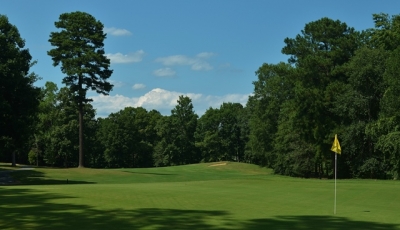 |
| From the start, you will see Blue Heron as a beautiful, natural golf layout. Here, the green of the par four 1st hole. |
Since there's only one Pinehurst, it makes sense that if you're going to get the 'experience' more than just once in a while (or lifetime), you'll need to bring the Pinehurst feel to you. And that's exactly what they did when creating the Blue Heron course at Ford's Colony. (Pinehurst's history is harder to transport, however.)
Pinehurst's legend was built around course architect Donald Ross, who masterminded the first several Pinehurst golf courses (now called Pinehurst Resort) and a man who tinkered with course #2 until his final days. It was Ross's life's project, and today only a fool would consider leaving it off a list of the world's greatest golf courses.
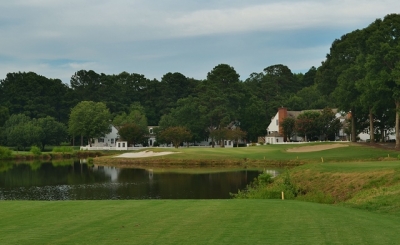 |
| The par three 17th hole is practically all carry -- a real test of nerve. |
#2's recent restoration by Ben Crenshaw and Bill Coore gave it a 'retro' look and perhaps started a new trend in golf course design, proving that hard and fast 'brown' conditions can still be popular.
Pinehurst's fame only increased with its hosting of several recent U.S. Opens, including both the women's and men's in 2014 -- in consecutive weeks.
It was also the scene of arguably the most memorable golf tournament in history, the 1999 Open (where Payne Stewart sank the winning putt on the 18th hole, four months before his death). If a Hollywood screenwriter had written up the closing scenario, every producer would've laughed him out of the studio -- and deposited the work safely in the round file labeled 'fantasy, could never happen.'
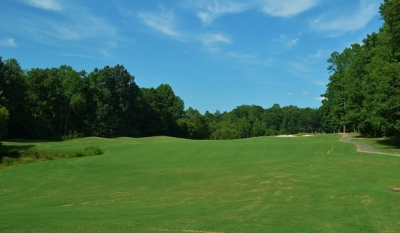 |
| Get plenty of distance off your drive on the par four 5th hole, or the second shot is blind. |
Richard Rice, Ford's Colony's Head Golf Professional, says when he's out on the Blue Heron course, he thinks of Pinehurst. "I like to think the Blue Heron course has a real Pinehurst look and feel to it -- especially on the newest nine (holes 5-13). It's got the pines and the tall trees out there, quite a contrast to what you'd find farther north, with mainly oaks and hardwoods."
"It's also kind of spread out on that course, so there's quite a feel of isolation, just like you get at Pinehurst."
I can see where Rice would see a lot of Pinehurst in Blue Heron, especially since a living legend of Pinehurst journeyed to the Old Dominion to design the course. Dan Maples is as much a part of Pinehurst lore as his father was, and his father (and grandfather) tutored under none other than Donald Ross himself. Maples still makes his home there.
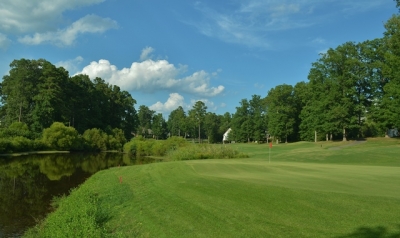 |
| The 385 yard, par four 11th hole demands accuracy from tee to green. |
In other words, if there's one man who could bring Pinehurst to Williamsburg, it'd be Dan Maples. Maples, however, is much too humble to take all the credit. He said the Ford's Colony property deserves a lot of the acclaim. "The terrain at Ford's Colony is really varied, and presented a lot of good ground to work with. We don't have quite the same variation down here in Pinehurst, so I had the opportunity to do some things at Ford's that wouldn't be as possible down here."
One thing's for sure, finding an abundance of trees isn't a problem in either locale. But Maples says he'll never design a hole specifically around a tree, because you never know how long it'll be around.
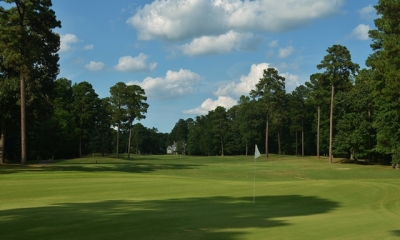 |
| Greenside at the 9th hole, you'll quickly grasp why Richard Rice says the Blue Heron Course reminds him of Pinehurst. |
"We extensively walk each course we work on -- and tag the trees we want to keep. Sometimes we'll even design a split fairway around a particularly attractive tree, but we always try to make sure it's a good hole regardless of whether the tree's there or not. Let's face it -- trees aren't permanent."
There aren't any tree centered split fairways on the Blue Heron, but Maples says there're still plenty of beautiful trees out there. "The land for the Blue Heron course -- especially on the newest nine, presented a lot of natural beauty, with the tree lined fairways and the wetlands. We basically sculpted everything from tee to green, and the contours are excellent. That's kind of a change from the old days -- you're certainly better able to attend to detail on the courses more than in years past."
There are eighteen great holes on Blue Heron, but I'd say the newest nine is slightly more spectacular than any of the others at Ford's Colony. It's simply a journey through a pristine, undulating piece of Virginia forest, where you'll never quite see how the next hole can trump the previous one. But somehow, it finds ways.
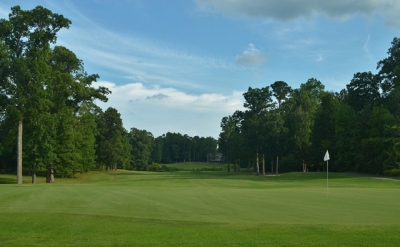 |
| It's hard to tell from the picture, but the 12th hole's a risk-reward 505 yard par five that will thrill and challenge you. |
There's also something "new" about Blue Heron. The course was closed in 2013 to change the grasses on its greens. Rice says they redid the putting surfaces with a new strain of dwarf champion Bermuda grass.
The Pinehurst folks have also changed over their greens to Bermuda grass (including Pinehurst #2 after the 2014 U.S. Opens) -- yet another connection.
Rice thinks Blue Heron's greens are now among the best in Williamsburg. We agree.
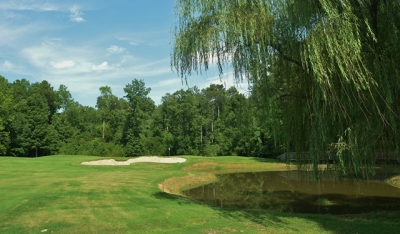 |
| This pond should not come into play on the par four 3rd hole, but it certainly adds to the beautiful scenery on the Blue Heron course. |
The greens putt true, but Rice says the difficulty on the course comes primarily from its par threes. "Around these parts, the Golden Horseshoe gets most people talking about the best set of par threes in the state. I think the par threes on Blue Heron deserve to be ranked up there in that category."
We'd have to agree. The one-shotters on Blue Heron are spectacular, with uphill shots, downhill shots, shots over wetlands, shots over lakes -- a lot of variety -- and quality. They're long and difficult, too -- with the shortest being number eight at 175 yards. The others can stretch out to almost two hundred yards, with #17 being the most difficult -- 192 yards with almost a full water carry.
When you stand on that tee box, your knees quiver.
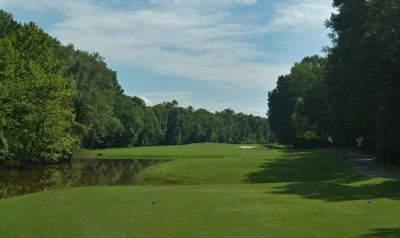 |
| The par five 4th hole does not look all that intimidating, but you can make a big number here. |
Blue Heron is also the longest of Ford's Colony's three courses, 6928 from the back tees and a slope of 134. Just as with the other two layouts at Ford's Colony, there are generally good sized landing areas and everything's in front of you. The woods probably come into play more on this course than the others, but that goes along with the Pinehurst feeling.
But just as with the legendary Pinehurst courses, Blue Heron is eminently playable for all skill levels, if you choose the right set of tees.
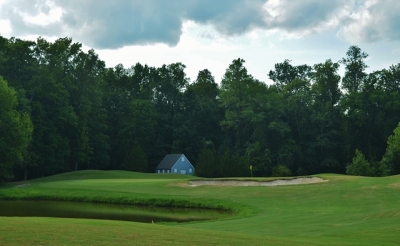 |
| Another demanding approach shot on the 13th hole -- take enough club to fly the water but stay out of the bunkers on the right. |
One final note before I describe some of the golf holes -- Blue Heron's conditioning was outstanding (all three courses were in excellent shape, actually). The greens rolled quick and true, similar to Williamsburg's finest championship golf courses.
The course starts out with three good par fours, all hovering in the 400 yard range. All feature doglegs that go right, left, left respectively. Each has its own unique characteristics. The first has a downhill tee ball that could easily roll through the fairway if you don't club down, then an approach shot to a slightly elevated green over a large bunker at front-left.
The third offers your first glance of water on the course, laying to the extreme right of the green -- more for scenery than danger. But that'll come on the next hole.
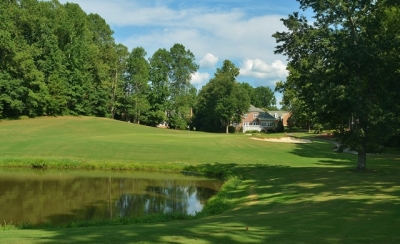 |
| The par three 6th hole looks deceptively long from the tee. |
The fourth is one of the most difficult par fives I've ever played. Rice says "Blue Heron's number four is probably the one hole in the entire complex where you can make a big number if you're not careful." It's true. Off the tee, you have water down the left side, and a bunker to the right with out-of-bounds to the extreme right and water just beyond the bunker. Even the second shot has considerable danger, unless you have a real solid tee ball -- because the lake will come very much into play and the layup landing area isn't large. Tough hole.
Holes five through thirteen comprise Blue Heron's newest nine -- the stretch that reminds me most of Pinehurst, and what I think is Ford's Colony's strongest nine hole run. Five's an extremely pleasing par four with a tee ball to an elevated fairway. If you don't get enough distance, you won't be able to see the green, so don't spare the driver!
Six is the first of the four challenging par threes Rice spoke of. The tee shot's over wetlands and water to an elevated green, with bunkers right and long.
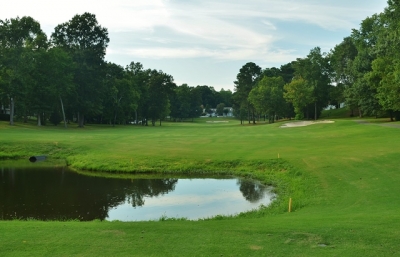 |
| The par five 16th hole is a good birdie opportunity if you place your drive to the left side of the fairway. |
Eleven through thirteen are probably Blue Heron's most picturesque holes, all bringing water and wetlands into play. Eleven's got an elevated tee box with plenty of room in the landing area. The second shot must avoid the wetlands on the right. Pretty scene, good golf hole.
Twelve wins the most intimidating tee shot award -- from the back box, it looks like a full carry over wetlands to a narrow fairway. Well, that's partially true. It's a full carry over wetlands, but once you get out there, you'll see there was plenty of room to drive it to.
Thirteen's downhill all the way, and 405 yards of par four. Consider clubbing down off the tee to avoid a lake that could come into play if you get a hold of one and get some roll.
Jumping to seventeen, it's one of the most difficult par threes I can remember (so when you combine the fourth and seventeenth, you've got two pretty darn difficult holes on the Blue Heron course!). It's difficult because it's a long, full carry par three with bunkers fronting the green, and the only realistic bailout is to the extreme right, and short. The only good option's to hit the green, which is easier said then done -- the hole can play over 200 yards. But the putting surface is large!
Eighteen's a relatively tame 398 yard par four with a sharp dogleg left. The second shot can be tough if you're too far to the left off the tee and there's a back left pin position. Tree trouble!
It's probably not going to be the first time on Blue Heron that you'll encounter trees. But the grandeur of the experience won't be lessened by the great amount of nature's presence. The tall pines heighten the golf course, as they will your golf round. And it's nice there are shades of Pinehurst, right here in the Old Dominion.
Details:
The Blue Heron Course At Ford's Colony
240 Ford's Colony Drive
Williamsburg, VA 23188
Phone: (757) 258-4130
FAX: (757) 258-4168
Website: www.fordscolonycc.com
Course Designer: Dan Maples
Head Golf Professional: Richard Rice
Membership Information and Rates:
Ford's Colony Country Club is now under ClubCorp. Consult the website for rates.
Ford's Colony is also one of the nation's leading residential communities. For more information, visit FordsColony.com.
| Related Links | Comments on this article? | |
|
Maryland National Golf Club Hollow Creek Golf Club Rocky Gap Resort PB Dye Golf Club in Ijamsville Whiskey Creek Golf Club |
E-mail Jeff Rendall, Editor: jrendall@golftheunitedstates.com |











